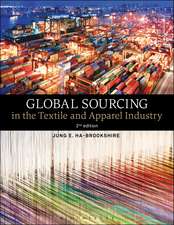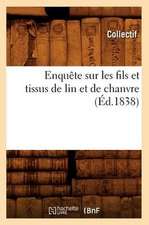The Fashion Business Reader
Editat de Joseph H. Hancock, Anne Peirson-Smithen Limba Engleză Paperback – 12 iun 2019
| Toate formatele și edițiile | Preț | Express |
|---|---|---|
| Paperback (1) | 253.83 lei 22-36 zile | |
| Bloomsbury Publishing – 12 iun 2019 | 253.83 lei 22-36 zile | |
| Hardback (1) | 787.68 lei 22-36 zile | |
| Bloomsbury Publishing – 12 iun 2019 | 787.68 lei 22-36 zile |
Preț: 253.83 lei
Preț vechi: 297.64 lei
-15% Nou
Puncte Express: 381
Preț estimativ în valută:
48.58€ • 50.53$ • 40.10£
48.58€ • 50.53$ • 40.10£
Carte disponibilă
Livrare economică 24 martie-07 aprilie
Preluare comenzi: 021 569.72.76
Specificații
ISBN-13: 9781474279543
ISBN-10: 1474279546
Pagini: 528
Ilustrații: 38 b&w illus
Dimensiuni: 189 x 246 x 23 mm
Greutate: 1.16 kg
Editura: Bloomsbury Publishing
Colecția Bloomsbury Visual Arts
Locul publicării:London, United Kingdom
ISBN-10: 1474279546
Pagini: 528
Ilustrații: 38 b&w illus
Dimensiuni: 189 x 246 x 23 mm
Greutate: 1.16 kg
Editura: Bloomsbury Publishing
Colecția Bloomsbury Visual Arts
Locul publicării:London, United Kingdom
Caracteristici
With introductions to every book section and every reading, plus guides to further reading, the reader is the ideal course text for students and the perfect desk reference for scholars researching across a wide range of topics
Notă biografică
Joseph Hancock is a professor at Drexel University, USA, in the department of design. He has worked in management, branding, merchandising, and leadership for landmark companies, including The Gap, The Limited Corporation, and Target Corporation. He is the principal editor for the journal Fashion, Style & Popular Culture.Anne Peirson-Smith is an assistant professor at City University of Hong Kong. She teaches and researches fashion communication, public relations, popular culture, and the creative industries. In addition to a global professional background in public relations and branding she is the co-author of Public Relations in Asia Pacific (2009), Global Fashion Brands (2014), and Communicating Transcultural Fashion (2018). She is also associate editor for the journal Fashion, Style & Popular Culture.
Cuprins
List of Illustrations and List of Contributors Acknowledgements Introduction and How to Use This Book Part I: History of Fashion and Product Development Introduction: Jose Blanco, Dominican University 1. Pamela Barker and C Phyllis Tortora, Influence of North American Indian and First Nations Dress on Mainstream Fashion, Berg Fashion Library 2. Norma Rantisi, How New York Stole Modern Fashion, Berg Fashion Library 3. Joseph H. Hancock, II. (2011) A Deconstructionist Perspective on Menswear: A Conversation with Siki Im, Fashion Practice, Volume 3, Issue 1, May, Taylor & Francis 4. Lewis Van Dyk and Keith Fraley (2015), Patrick Kelly: Fashions' Great Black Hope, Fashion, Style and Popular Culture, Intellect, Volume 2, Issue 3, pp 333-350 5. Bonnie English (2007) Japanese Conceptual Fashion. In A Cultural History of Fashion in the 20th Century: From Catwalk to the Sidewalk, 117-35, Berg. 6. Barbara Vinken (2005), Martin Margiela: Signs of the Time, in Fashion Zeitgeist: Trends and Cycles in the Fashion System, Oxford: Berg, 127-57. Guide to Further Reading Part II: Sourcing & Manufacturing Introduction: Alphonso McClendon, Drexel University 1. Brian Goldbold,(2000) The Chain Store Challenge. In The Fashion Business: Theory, Practice, Image. Oxford: Berg, 103-117. 2. Luigi Maramotti, (2000), Connecting Creativity. In Fashion Business: Theory, Practice, Image. Oxford: Berg, 91-103. 3. Kamlesh Singh and Nancy Hodges, (2011) Buyer- Suppliers Partnerships in the Global Apparel Industry: A Study of US Buyers and Indian Suppliers, Fashion Practice, Volume 3, Issue 2, , Taylor & Francis 4. Colin Gale and Jasbir Kaur (2004) Business and Industry. In Fashion and Textiles: An Overview. Oxford: Berg. 87-117. Guide to Further Reading Part III: Sustainability & Social Responsibility Introduction- Tasha Lewis, Cornell University 1. Ben Barry (2014), Selling Whose Dream? A Taxonomy of Aspiration in Fashion Imagery, in Fashion, Style and Popular Culture, Intellect, Volume 1, Issue, 2, pp 175-92. 2. Joy, Sherry, Venkatesh, Wang and Chan, (2012) Fast Fashion, Sustainability and The Ethical Appeal of Luxury Brands, Fashion Theory, Volume 16, 3, Taylor & Francis 3. Sharron Hepburn, In Patagonia (Clothing): A Complicated Greenness, 2013, Fashion Theory, Volume 17, Issue 5, Taylor & Francis 4. Liat Smestad, (2009) The Sweatshop, Child Labor and Exploitation Issues in the Garment Industry, Fashion Practice, Taylor & Francis 5. Valerie Rangel (2014), Dress and Disaster: Fashioning Creative Responses to Disaster, in Fashion, Style and Popular Culture, Volume 1, Issue, 2, pp161-173, Intellect Guide to Further Reading Part IV: Brick-and-Mortar Retailing & Shopping Introduction- Catherine Weiss, Lasell College 1. Cynthia Cooper, The Garment Industry and Retailing in Canada, Berg Fashion Library 2. Michael Mamp and Sara Marcketti (2015), Creating a Woman's Place: The Bonwit Teller Presidency of Hortense Odlum, 1934 to 1940, Fashion, Style & Popular Culture, Volume 2, Issue 3, pp. 301-19, Intellect. 3. Myles Ethan Lascity, Stores, Shoppers and Mediated Images: The Relational Space of Uniqlo. New article.4. Annita Boyd, (2014) 'Oh, honey! It's Not So Much the Style, it's what carrying it means': Hermés Bags and the Transformative Process, Fashion, Style & Popular Culture, Intellect, pp 81-96. Guide to Further Reading Part V: Media & Omni-Channel Retailing Introduction - Nioka Wyatt, Philadelphia University 1. Brent Luvaas (2013), Shooting Street Style in Indonesia: A Photo Essay, Clothing Cultures, Volume 1, Number 1, pp 59-81, Intellect. 2. Juanjuan Wu, (2010) Co-Design Communities Online: Turning Public Creativity into Wearable and Sellable Fashions, Fashion Practice, Volume 2, Issue 1, Taylor & Francis 3. Kendra LaPolla, ModCloth: A Case Study in Co-Creative Branding Strategies, in Global Fashion Brands, Intellect, pp. 85-102. 4. Frances Ross, (2012) A Study of How Small and Medium-sized Enterprise Tailors Utilize e-Commerce, Social Media, and New 3D Technological Practices, Fashion Practice, Volume 4, Issue 2, Taylor & Francis. 5. Caroline Czajkowski and Tasha L. Lewis, Yoga, Facebook, and Fandom: Examining Brand Devotion by Lululemon Customers Using Social Media. New article. Guide to Further Reading Part VI: Fashion Merchandising & Strategy Introduction: Joseph H. Hancock, II Drexel University 1. Marilyn Delong, Mary Alice Casto, Meghan McKinney, Harini Ramaswamy, Natasha Thoreson and Seoha Min, (2014) Curating Cinderella: A Holiday Extravaganza at Marshall Field's, Fashion, Style and Popular Culture, Intellect, pp 45-63. 2. Andrade, Rita (2005) Mappin Stores: Adding an English Touch to the Sao Paulo Fashion Scene. In: Regina Root (ed) The Latin American Fashion Reader. Oxford: Berg. 3. Jennifer Craik (2005) Fashioning Sports Clothing as Lifestyle Couture: Sport Clothing as Fashion. In: Uniforms Exposed: From Conformity to Transgression. Oxford: Berg. pp. 161-174. (which chapter are we using? - Biblio contents gives the above, but the document Jo sent is the previous one - 'Sporting Bodies and Disciplined Selves.') 4. Edwina Luck, Gjoko Muratovski and Lauren Hedley, (2014) Co-branding Strategies for Luxury Fashion Brands: Missoni for Target, Global Fashion Brands, Intellect, pp41-56. 5. Anne Peirson-Smith (2014) Comme on Down and Choos Your Shoes: A Study of Consumer Responses to the Use of Guest Fashion Designers by H&M as a Co-Branded Marketing Strategy, Global Fashion Brands, Intellect pp 57-82. Guide to Further Reading Part VII: Fashion Branding Introduction - Veronica Manlow, Brooklyn College 1. Tasha Lewis and Natalie Gray, (2013) The Maturation of Hip Hop's Menswear Brands: Outfitting the Urban Consumer, Fashion Practice, Volume 5, Issue, 2, Taylor & Francis 2. Lee Barron, (2007), The Habitus of Elizabeth Hurley: Celebrity, Fashion, and Identity Branding, Fashion Theory, Volume 11, Issue 4, Taylor & Francis 3. Veronica Manlow, (2011) Creating an American Mythology: A Comparison of Branding Strategies in Three Fashion Firms, Fashion Practice, Volume 3, Issue 1, Taylor & Francis 4. Nick Rees Roberts, Raf Simons and Interdisciplinary Fashion from Post-Punk to Neo-Modern, in Fashion Theory: Volume 19, Issue 1, pp.9-41 5. Anne Peirson-Smith, (2013) Wishing on a Star: Promoting and Personifying Designer Collections and Fashion Brands, Fashion Practice, Volume 5, Issue 2, Taylor & Francis Guide to Further Reading Part VIII: Fashion Communications Introduction: Anne Peirson-Smith, City University of Hong Kong 1. Bruce H. Joffe, (2008) Skivvies with the Givvies: Vintage American Underwear Ads Feature Sexual Innuendo between "Boys" in the Brands, Textile, Volume 6, Issue 1, pp. 4-17, Taylor & Francis. 2. Twigge, Julia (2013) Magazines, the Media and Mrs Exeter In: Fashion and Age: Dress, the body and later life. London: Bloomsbury. 97-117.3. Church Gibson, Pamela (2012) The Changing Face(s) of the fashion magazine and the new media landscape. In: Fashion and Celebrity Culture: London: Berg. 125-138. 4. Jobling, Paul (1999) Who's that girl: Alex and Kate - a tale of two bodies in contemporary fashion photography. In: Fashion Spreads: Word and Image in Fashion Photography since 1980. Oxford: Berg, 111-141. 5. Kamamura, Yuniya (2005) Production, Gatekeeping and Diffusion of Fashion. In: Fashion-ology: An Introduction to Fashion Studies. Oxford: Berg, 73-93. Guide to Further Reading Part IX: Consumption & Identity Introduction: Srikant Manchiraju, Florida State University 1. Herbert Blumer, Adam Smith and Thorstein B. Veblen, Fashion as Collective and Consumer Behavior, Berg Fashion Library 2. Annette Lynch and Michael Strauss D, (2007) Fashion as Cycle: in Changing Fashion: A Critical Introduction to Trend Analysis and Meaning. Oxford: Berg 127-50. 3. Twigg, Julia (2013) The High Street Responds: Designing for the Older Market. Fashion and Age: Dress, The Body and Later Life. London: Bloomsbury, 119-42 4. Kevin Matthews, Joseph H. Hancock, II, Zhaohui Gu, ReBranding American men's heritage fashion through the use of visual merchandising, symbolic props and masculine iconic memes historically found in popular culture, in Critical Studies in Men's Fashion, Volume 1 Issue 1 (2014), pp. 39-58 5. Benjamin L. Wild (2015), To Have and To Hold: Masculinity and The Clutch Bag, Critical Studies in Men's Fashion, Volume 2, Number 1, pp. 43-54, Intellect. Guide to Further Reading Part X: Global Fashion & Reinvention Introduction: Brent Luvaas, Drexel University 1. Jennifer Craik, Is Australian Fashion and Dress Distinctively Australian? Fashion Theory, Volume 13, Issue 4, 2009, Taylor & Francis 2. Karen Hanson and Tranberg, Secondhand Clothing, in eds. Joanne B. Eicher and Phyllis Tortora, Berg Encyclopaedia of World Dress and Fashion (Bloomsbury) 3. Margaret Maynard, Globalization and Dress, in eds. Joanne B. Eicher and Phyllis Tortora, Berg Encyclopaedia of World Dress and Fashion (Bloomsbury)4. Simona Seigre Reinach, Milan: The City of Pret-a-Porter in a World of Fast Fashion, in eds. Christopher Breward and David Gilbert, Fashion's World Cities (Bloomsbury) 5. Christine Tsui, (2013) From Symbols to Spirit: Changing Conceptions of National Identity in Chinese Fashion, Fashion Theory, Volume 17, No. 5, Taylor & Francis,. Guide to Further Reading Part XI: Beauty and The Body Introduction: Ethan Lascity, Independent Scholar 1. Vincent, Susan J. (2009) Epilogue: Fashioning the body today. The Anatomy of Fashion: Dressing the Body From the Renaissance to the Present Day, Oxford: Berg, 158-74. 2. Maria Mackinney-Valentin, Face Value: Subversive Beauty Ideals in Contemporary Fashion Marketing, Fashion, Style & Popular Culture, Intellect, pp 13-27. 3. Joseph Hancock (2016), All Races, All Sexes, All Genders: M.A.C., Brand/Story: Cases and Explorations in Fashion Branding 2nd Edition, Fairchild (Bloomsbury) 4. Janice Miller, Making Up is Masculine: The Increasing Cultural Connections Between Masculinity and Make-Up, Critical Studies in Men's Fashion, Volume 1, Issue 3, pp 241-53, Intellect. 5. Sarah Cheang and Geraldine Biddle-Perry (2008), Hair and Human Identity, Hair: Styling, Culture and Fashion, pp. 243-253. 6. Leena- Maija Rossi (2007), Outdoor Pornification: Advertising Heterosexuality in the Streets, in Pornification: Sex and Sexuality in Media Culture, pp. 127-138, Oxford: Berg. Guide to Further Reading List of Illustrations Index
Recenzii
I am not aware of any other book that covers the fashion industry in this breadth, from creation to consumption.
The Fashion Business Reader has filled a gap in our discipline. A reader solely on retail is exactly what many of us in academia have needed as a go-to reference when working on our own research or preparing for our classes.
A fantastic resource and collection of texts which take a cultural and critical approach to understanding the 'business' of fashion.
The Fashion Business Reader has filled a gap in our discipline. A reader solely on retail is exactly what many of us in academia have needed as a go-to reference when working on our own research or preparing for our classes.
A fantastic resource and collection of texts which take a cultural and critical approach to understanding the 'business' of fashion.





















